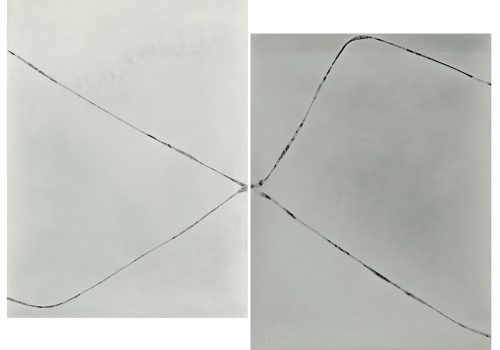The Confine exhibition by young Italian photographer Vittoria Gerardi (born in 1996) is one of the most astonishing that I have seen lately. Her photographs are as intriguing as they are surprising. Confine is a series of abstract compositions taken from a three-week trip in Desert Valley (United States). The abstraction of simple landscape shots, the infinite variations of gray tints as well as the use of light reveals a work of very rare finesse.
I often hear that an abstract work requires an explanation for, on one hand, being understood, and on the other, for being appreciated. Without denying this need nor getting into an eternally repeated debate, I firmly believe that one can like an abstract work for its simple aestheticism. One can admire it by looking at it at length, asking oneself how she did it, by letting one’s imagination drift. The work can intrigue you and that is the first victory. With Vittoria Gerardi, there is nothing more than a simple invitation to be curious. We observe form, contrast, light. All of it is very simple. Described as such, observation could stop there. It is so with the work Confine n°295 et 296, four lines criss-crossing and meeting in the middle by two adjoining panels.
I can also unpack my “picnics”, as wrote François Morellet, and tell you what I understand of it all. My imagination would overflow, and I would write, taken by madness or out of the ordinary nerve, that these simple crossing lines show a secret meeting of four climbers scheming on the white peaks of the Alps. In front of Confine 116, I may become become delirious, but right there is a piece of the moon covered, little by little, by a sea of nitrous liquid! When I arrive at Confine 55, it is an aerial view of North Korea’s demilitarized zone. Only, decency holds me back. I never wrote that, you’ll surely agree.
You can see that abstraction makes me say crazy things. I happily sink deep into my imagination. There is nothing comical nor deceitful behind these words. It’s simply a little boy’s fascination for work where the mind likes to lose itself. Curiously, when it is confronted with abstract work and gets lost, the mind rambles on and overflows. It almost systematically associates abstraction to a memory of reality. It clings onto representation: “this work, could be…,” and this work, “ looks like…” It reflects on our interpretations of the work and then, like a wake-up call, comes the artist’s or institution’s statement.
It is sometimes dissonant, sometimes mysterious, sometimes receptive, sometimes entertaining. It has an authority, but everyone knows that it is the viewer who makes the piece. The two feed off each other, complete each other, oppose each other. It doesn’t matter. Thierry Bigaignon told us that Vittoria Gerardi constructed “symbolic frontiers between material and time, between space and light, as to better mark the landscape with a scar, an imaginary horizon.”
As general practice, let’s accept it entirely. From then on, my representation of the work begins to change. Hereafter, these same works that I observed transform into a balancing act, a type of space where united backgrounds confront each other. In these sparse, defined spaces, sometimes just with haphazardly running lines, we can find the detail of a rock, a mountain fragment, in short, a small piece of Death Valley.
So, light is defined by a strictly limited zone where the landscape is a positive. We find this light in the line, in a square, in a sun’s halo. There, we see, a minuscule, Death Valley, whereas space is revealed as the depth of the works, not printed but refined by chemical products, a kind of grand ensemble where landscape remains surrounded, enclosed, revealed. It is this balance between the real landscape (the light, Death Valley) and the abstract landscape (its backgrounds not printed, not marked) that creates the abstraction.
However, whatever the message of the work, there remains this curious vertigo. No matter what my thoughts, my imagination, even the words of the artist, there is still this curious vertigo. Whether my representation of the work is altered or completed by an explication, we still have this curious vertigo… that remains in the back of the eye, the curiosity and feeling of capturing the essence of the photograph, that is the light.
In front of Vittoria Gerardi’s work, I have the impression of finally having briefly been able to capture this quintessence. And this new thought makes me freeze, opens a universe which I think is captivating. It’s the only world that summarizes my admiration. Printing, the thousands of grays, everything is reconstructed at most. Everything is pared down drawn out, tightened up by the search for the essential element of light. All that is needed is a method, an aesthetic search, trial-and-error in the dark room, long hours of reworking.
And is that actually sufficient? In front of these abstract photographs comes the idea of a simple piece in its result, however complex to create. That is the paradox of bringing an idea to life. We have an image of it, but we lack the words. How many tries are necessary to most closely achieve our first idea? Vittoria Gerardi had sometimes made nine prints for one final result. The exhibition consists of thirty works. You can calculate, dear reader, how much persistence one idea requires in order to come together. And if these words please you, if the photography intrigues you, don’t hesitate and go see the work of Victoria Gerardi.
Arthur Dayras
Arthur Dayras is an author specialized in photography who lives and works in Paris.
Vittoria Gerardi, Confine
September 16 through November 4, 2017
Galerie Thierry Bigaignon
9 Rue Charlot
75003 Paris
France
















